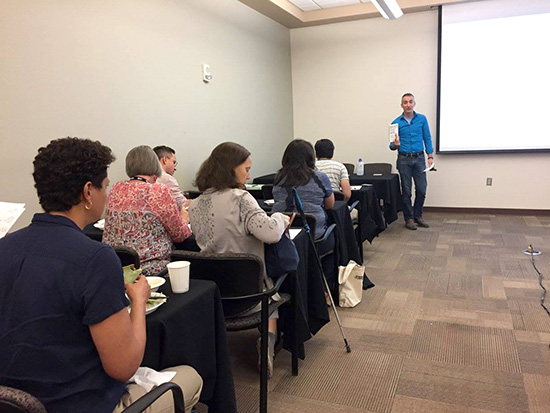Workshop Explores Ways to Get More Done
UNM Associate Professor of Statistics Erik Erhardt says faculty members who are feeling overloaded or overwhelmed with tasks should go beyond the typical “to do” lists and adapt an approach known as the Getting Things Done method.
He spoke during a presentation about time management sponsored by Advance at UNM in the SUB Sept. 8.
The method was developed by consultant David Allen, who wrote a book with the same title. It focuses on bringing out the brain’s ability to be creative, instead of using it as a filing cabinet.
“The basic idea here is your mind is for having ideas, not for storing them,” Erhardt said.
The system includes creating actions for each task on your list and even assigning a time for the action if possible. It also can help people create a process for dealing with interesting thoughts that come up in a meeting, for example.
 Getting Things Done works for people who think “I had a creative moment right now, but I can’t act on it, but I have to put it somewhere so that when I’m available to act on that thing, I don’t have to have to think that creative thought again,” Erhardt said.
Getting Things Done works for people who think “I had a creative moment right now, but I can’t act on it, but I have to put it somewhere so that when I’m available to act on that thing, I don’t have to have to think that creative thought again,” Erhardt said.
The method also encourages users to keep track of what’s next for a project so that when they need to step away from it, they can pick up again with something specific to do instead of having to rethink what the next steps were.
The method asks users to create a five-stage workflow for the tasks they need to do.
The stages are:
- Capture – keep track of ideas in whatever way is easiest for you. This could be an actual physical “inbox” of note cards or voice to text reminders list on a smartphone or tablet.
- Clarify – decide what you can do and what you can’t. This step has two answers (yes or no). From there, users can decide to trash an idea or item, incubate it, or use it as reference.
- Organize – put things where they go. This might mean creating the right types of list, i.e. “things to talk about the next time I see Janet,” a list for calls that have to be made, or items that you need at the store.
- Reflect – take time to review the lists and plans you have. This can be done every Friday for example. Keep reviewing to keep the system working, Erhardt said.
- Engage – this is the “Getting Things Done” part where you take action and move things off your list.
Implementing the system might not be easy or quick, Erhardt said, as it can take a while to adjust to a new way of organizing things that need to be done. The system can work for everything from personal tasks like remembering dog food to delegating work to others to deciding what steps are next in a big project.
“It’s going to feel uncomfortable because it’s a change,” he said.
Read more about the method here.

